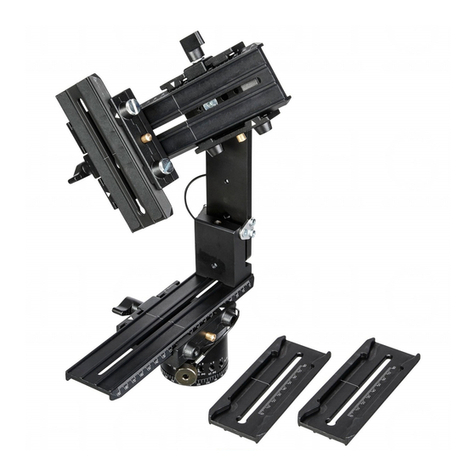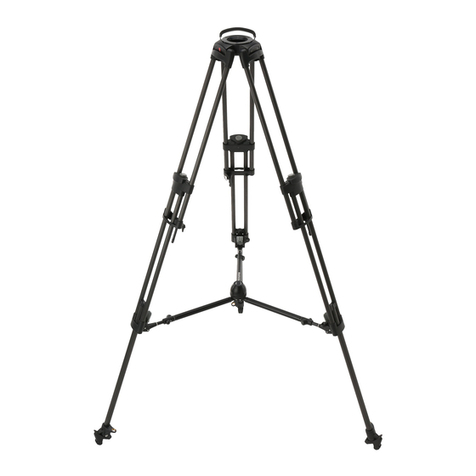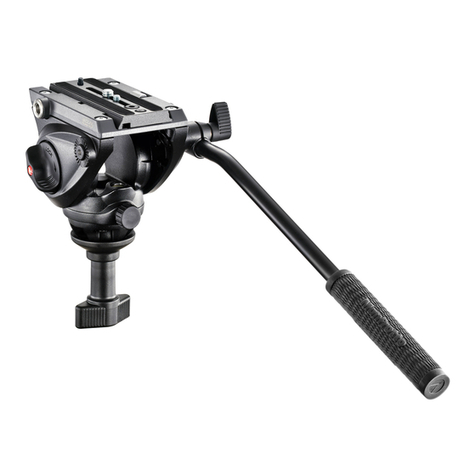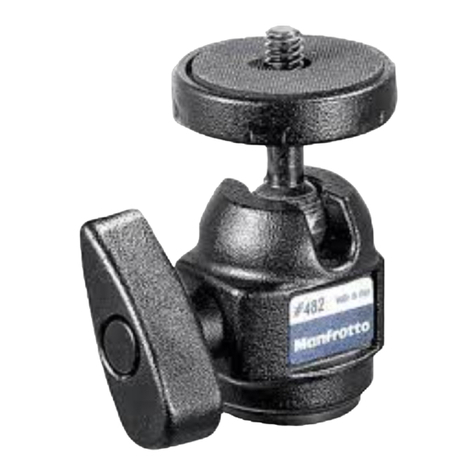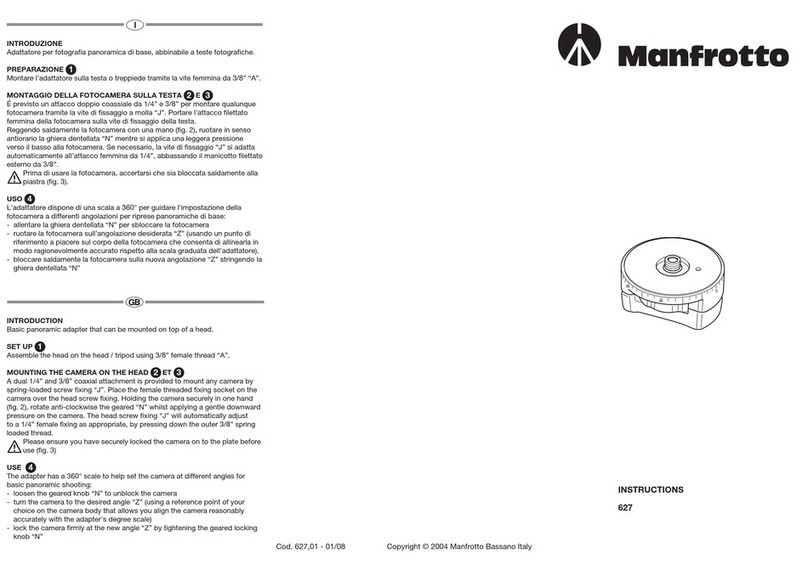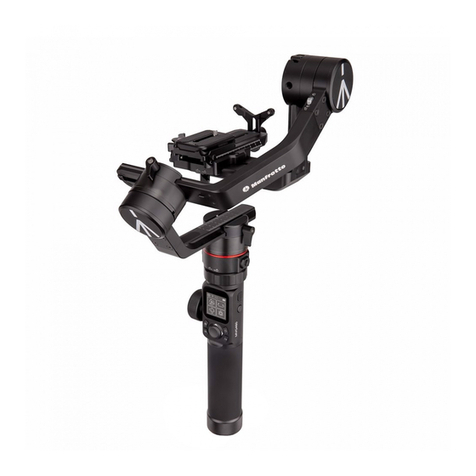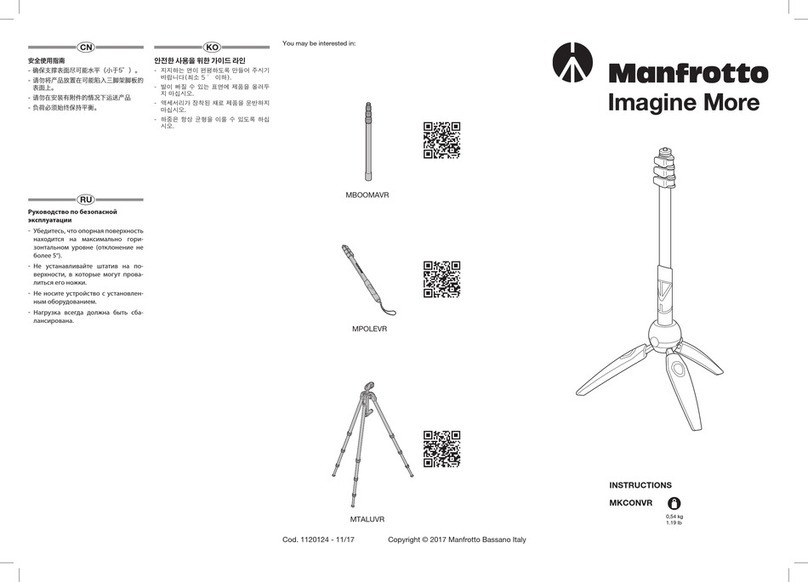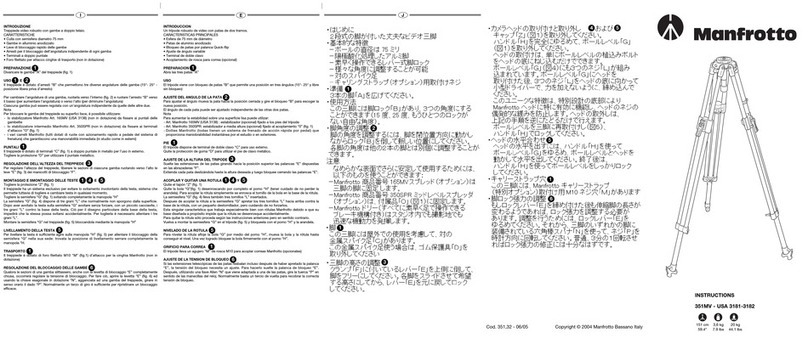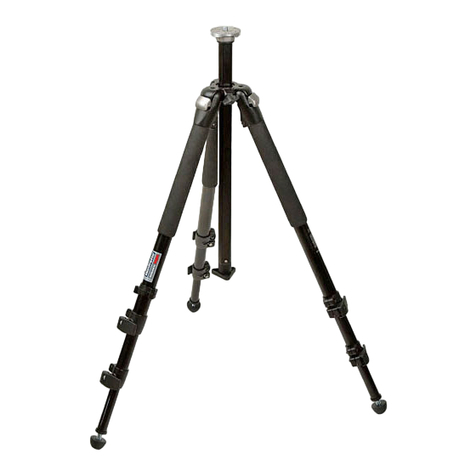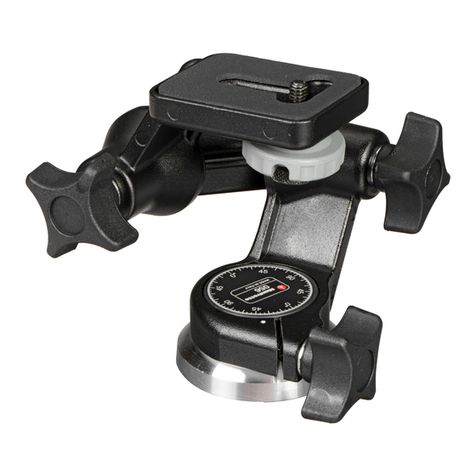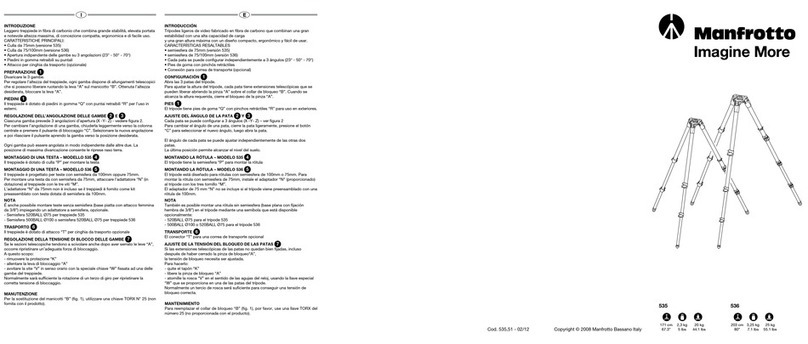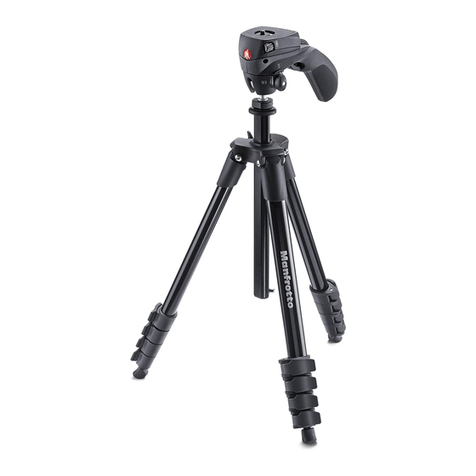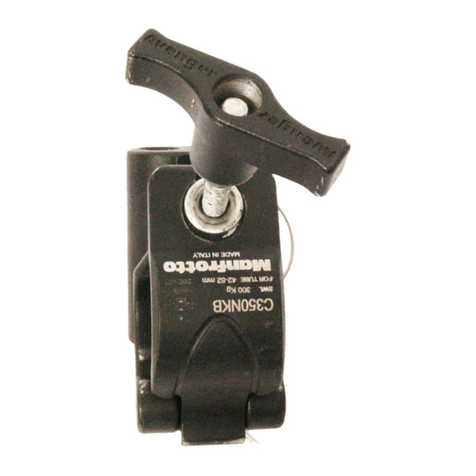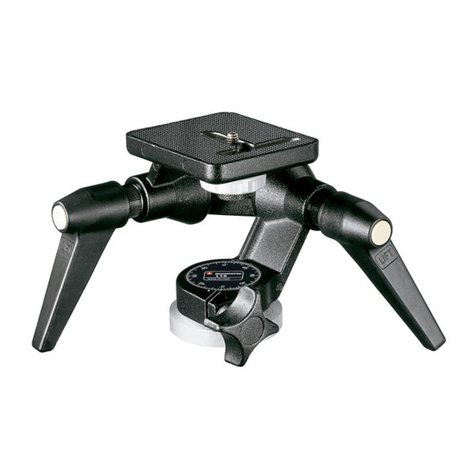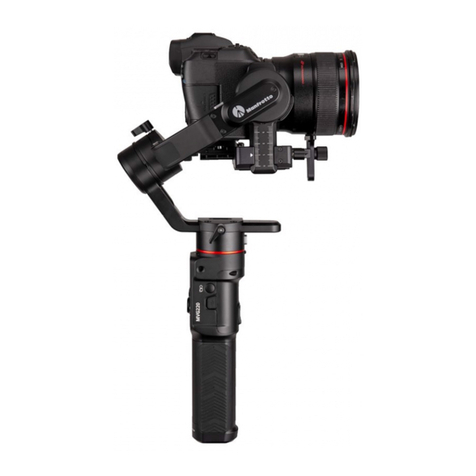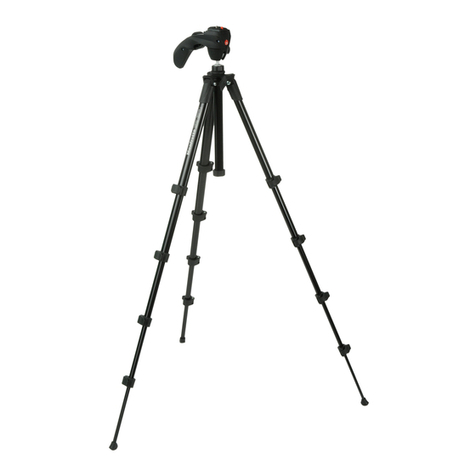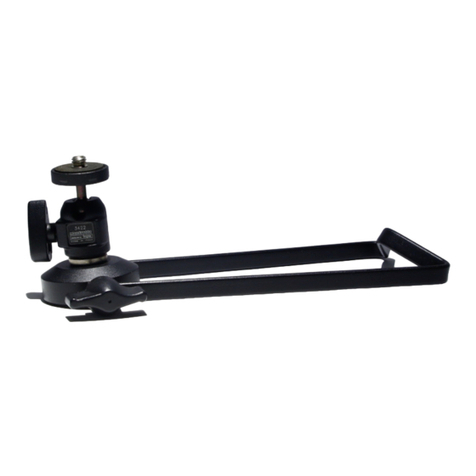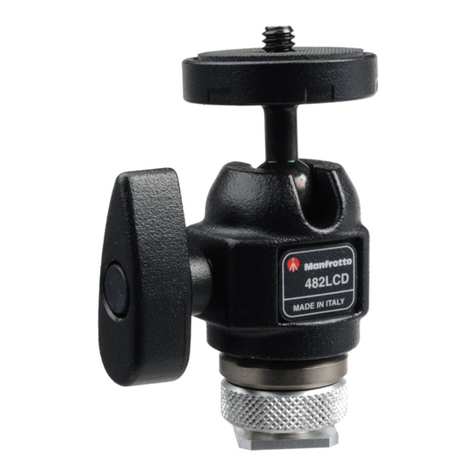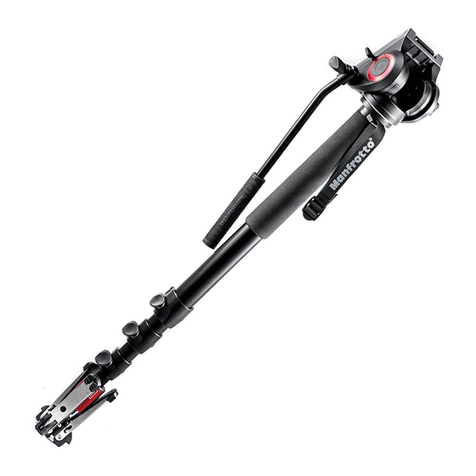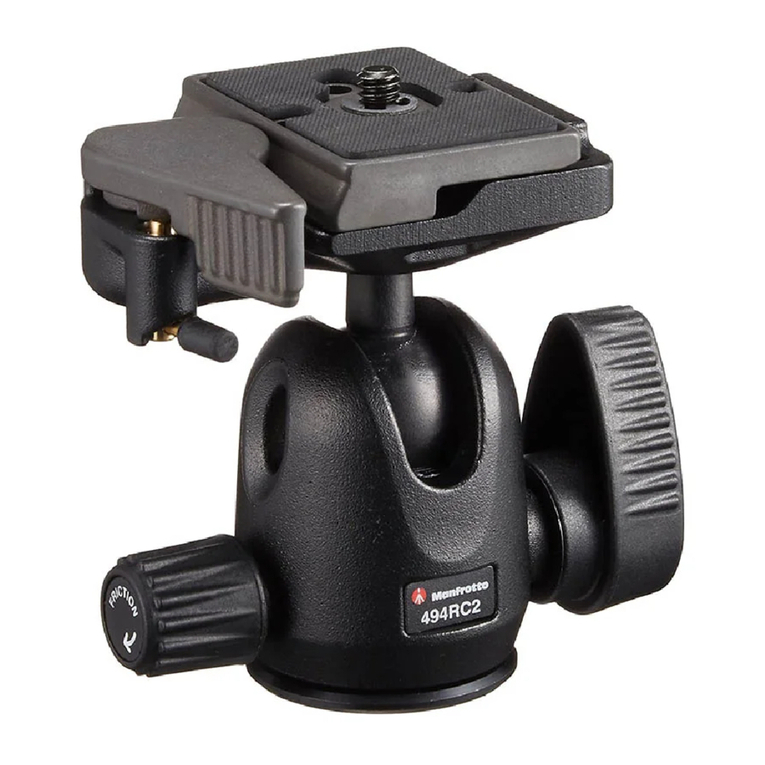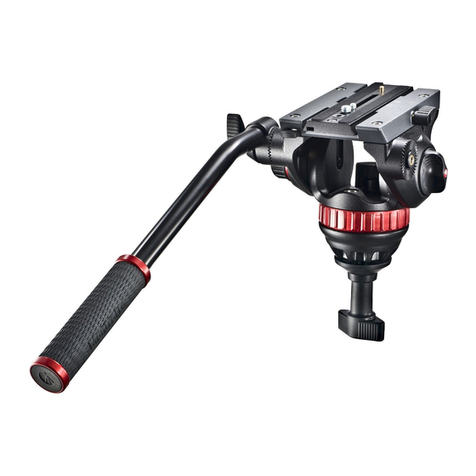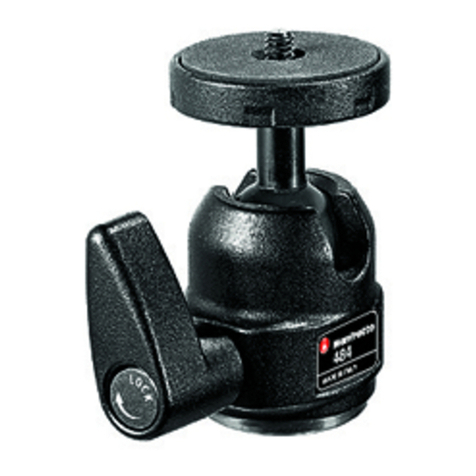INTRODUCTION
Trépied vidéo robuste avec jambes à doubles sections coulissantes en tandem.
CARACTERISTIQUES
• Bol d’un diamètre de 100 mm
• Jambes en aluminium anodisé
• Levier rapide de déblocage des jambes
• Réglage de l’angle d’écartement
• Doubles pointes en acier (version 350MV)
• Embouts en caoutchouc avec pointes rétractables (version 350)
• Filetage de fixation pour courroie de transport (courroie en option)
PREPARATION
Débloquez chaque clips “B”. Ouvrez les 3 jambes “A” jusqu’à l’écartement maximal.
Chaque jambe est dotée d’un loquet de blocage “V” permettant un écartement de 20° ou
bien libérant totalement la jambe.
MODE D’UTILISATION
REGLAGE DE L’ANGLE D’ECARTEMENT
Pour régler l’angle, ramenez la jambe dans la position fermée puis tirez sur le loquet “V” (voir
l’index rouge), la jambe ainsi est libérée.
L’angle de chaque jambe peut être réglé indépendamment.
Note: Pour augmenter la stabilité du trépied sur un terrain meuble, vous pouvez utiliser:
- Le stabilisateur Manfrotto Art. 165MV (USA 3138), fixé aux pointes du trépied 350MV (USA
3190-3193) (accessoire en option).
- Le stabilisateur Manfrotto Art. 165 (USA 3155), fixé aux pointes du trépied 350 (USA 3191-
3192) (accessoire en option).
- L’entretoise du milieu Manfrotto Art. 350SPR, fixée sur les attaches “O” (fig. 1).
- Les dollies Manfrotto (ils se déplacent rapidement et s’immobilise grâce à un système de
frein) facilitant les manœuvres de déplacement de l’appareil en studio ou en extérieur.
POINTES
Version 350MV
Le trépied a des doubles pointes en acier “C” adaptées pour un usage en extérieur.
Pour utiliser les pointes en acier, retirez les caoutchoucs “D”.
Version 350
Le trépied a des pieds en caoutchouc “Q” avec pointes rétractables en acier “R” pour une
utilisation en extérieur. Pour faire ressortir les pointes en acier “R”, poussez les petits leviers
“S” et introduisez les dans les fentes “T” en les tournant
REGLAGE DE LA HAUTEUR DU TREPIED
Libérez les sections des jambes en poussant vers le haut le levier “E” fixé sur la fonderie “F”.
Faites coulisser chaque jambe jusqu’à l’obtention de la hauteur désirée, puis rebloquez les
en refermant les leviers “E”.
MONTAGE ET DEMONTAGE D’UNE ROTULE ET
Retirez le bouchon en caoutchouc “Z” (fig. 1).
Retirez la demi - boule “G” (fig. 1) en dévissant complètement la poignée “H”.
Pour monter votre rotule, vissez la simplement sur la base de la boule.
La demi - boule “G” (fig. 4) est également dotée de 3 vis “L”.
Après avoir fixé la rotule sur la demi - boule “G”, et avec un petit tournevis, vissez les trois
vis sans têtes “L” jusqu’à ce qu’elles soient en butée contre la base de la rotule en faisant
attention à ne pas les forcer.
Cette caractéristique est adaptée à toutes les rotules Manfrotto, leur base ayant une forme
spécifique, empêchant ainsi tout desserrage accidentel.
Pour retirer la rotule, suivez tout simplement les instructions ci dessus dans le sens inverse.
Remontez la demi - boule “G” sur le trépied (fig. 5), et bloquez la avec la poignée “H”
MISE A NIVEAU DE LA ROTULE
Pour mettre à niveau la rotule, desserrez la demie sphère “G” en utilisant la poignée “H”,
bougez la boule et la rotule jusqu’à l’obtention de la mise à niveau.
Une fois obtenue, bloquez la boule fermement avec la poignée “H”.
FIXATION DE LA COURROIE DE TRANSPORT
Le trépied est muni d’un filetage femelle M10 “M” dans lequel vient se fixer la courroie de
transport (accessoire en option).
REGLAGE DU BLOCAGE DES JAMBES
Si les jambes télescopiques redescendent légèrement après avoir été bloquées avec le
levier “E”, la tension de blocage doit être réglée. Procédez dans l’ordre suivant :
Libérez le levier de blocage “E”, ensuite, à l’aide d’une clef Allen “N” fournie sur l’une des
jambes du trépied, tournez la vis “P” dans le sens des aiguilles d’une montre. Normalement
un quart de tour est suffisant pour obtenir une tension de serrage parfaite.
INTRODUCTION
Robust video tripod with tandem legs
KEY FEATURES
• 100 mm diameter ball
• Anodised aluminium legs
• Quick-flip lever leg locks
• Variable angle adjustment
• Twin spiked feet (350MV - USA 3190-3193 version)
• Rubber feet with retractable spikes (350 - USA 3191-3192 version)
• Attachment thread for carrying strap (optional)
SET UP
Unlock each of the clips “B”.
Open the 3 legs “A” until they reach their stop position.
The tripod is provided of leg locks “V” which permit either a 20° angle or a free position
USE
LEG ANGLE ADJUSTMENT
To adjust the angle, move the leg towards the closed position and pull down the lock “V”
(see red index) This now allows the leg to move freely.
The angle of each leg can be adjusted independently of the other two legs.
Note: To increase stability on a smooth surface, it is possible to use:
- Manfrotto Art. 165MV (USA 3138) spread (optional) fixed to the tripod’s feet 350 MV (USA
3190-3193)
- Manfrotto Art. 165 (USA 3155) spread (optional) fixed to the tripod’s feet 350 (USA 3191-3192)
- Manfrotto Art. 350SPR mid level spreader (optional) fixed to the attachment “O” (fig. 1)
- Manfrotto dollies (all have fast action foot controlled braking system) which provide instant
manoeuvrability around the studio or on location.
FEET
350MV version
The tripod has twin metal spike feet “C” for external use
Remove rubber protection “D” to use the metal spike feet
350 version
The tripod has rubber feet “Q” with retractable spikes “R” for external use.
To release push in the lever “S” and rotate into the slot “T” to expose the metal spike “R”.
ADJUST THE HEIGHT OF THE TRIPOD
Release the leg extensions by rotating to the upper position, the levers “E” attached to the
clamps “F”.
Slide out each leg until the desired height is attained then lock off by closing the levers “E”.
MOUNTING AND REMOVING A CAMERA HEAD &
Remove the cap “Z” (fig. 1).
Remove the half ball “G” (fig. 1), by unscrewing completely the handle “H”.
To mount your head simply screw the ball stud into the base of your head.
The half ball “G” (fig. 4) also has three screws “L” set in the ball.
After mounting head on the half ball “G”, tighten the three set screws “L” up against the
base of the head, with a small screwdriver, taking care not to force them.
This unique feature, which works especially well with Manfrotto heads due to their specially
designed base, prevents the head unscrewing accidentally.
To remove the head, simply follow the above instructions in reverse.
Re mount the half ball “G” on the tripod (fig. 5), and lock it with handle “H”.
HEAD LEVELLING
To level the head, loosen the half ball “G” using the handle “H” move the ball and head until
a level has been achieved.
Once this has been done, lock the ball firmly using the handle “H”.
CARRY-STRAP HOLES
The tripod has M10 threaded hole “M” for attaching Manfrotto carry-straps (optional extra).
LEG LOCK TENSION ADJUSTMENT
If the telescopic leg extensions slip even after having tightened the locking lever “E”, the
locking tension will need to be adjusted. In order to do this, release lock lever “E”.
Then, using the Allen key “N” provided on one of the tripod legs, rotate the screw “P”
clockwise. Normally a third of a turn will be sufficient to achieve the correct locking tension.
EINFÜHRUNG
Robustes Videostativ mit zwei Sektionen und Doppelstreben.
AUSSTATTUNGSMERKMALE
• 100 mm Nivellier-Pfanne mit Halbkugel
• Eloxierte Stativbeine mit Doppelstreben in beiden Sektionen
• Schnellverschlüsse zur Arretierung der Arbeitshöhe
• Variabler Beinanstellwinkel
• Füsse mit Doppelspikes (Version 350MV)
• Gummifüsse mit ausfahrbaren Spikes (Version 350)
• Einschraubgewinde für den optional erhältlichen Stativtraggurt
AUFSTELLEN
Lösen Sie alle drei Clips “B”. Öffnen Sie die drei Beine “A” bis zum Anschlag. Das Stativ
kann mit fixem (20°) oder variablem Beinanstellwinkel eingesetzt werden (Blockierung “V”).
GEBRAUCH
VERSTELLUNG DES BEINANSTELLWINKELS
Bewegen Sie das gewünschte Stativbein etwas nach innen. Ziehen Sie nun die Blockierung
“V” nach unten (siehe roter Index). Nun kann das Stativbein frei bewegt werden.
HINWEIS: Um eine erhöhte Stabilität auf glatten Untergründen zu erreichen, stehen
verschiedene optional erhältliche Zubehörteile zur Verfügung:
- Manfrotto Art. 165MV (USA 3138) Bodenspinne für Modell 350MV (USA 3190-3193) (zur
Fixierung des verstellbaren Beinanstellwinkels)
- Manfrotto Art. 165 (USA 3155) Bodenspinne für Modell 350 (USA 3191-3191) (zur
Fixierung des verstellbaren Beinanstellwinkels)
- Manfrotto Art. 350SPR Mittelspinne welche in die Ösen “O” eingehängt werden kann
- Verschiedene Manfrotto Stativwagen welche ein schnelles Verschieben des Stativs im
Studio und bei Aussenaufnahmen gewähren. Alle Modelle verfügen über eine
Schnellblockierung, welche mit dem Fuss aktiviert werden kann.
STATIVFUSS
VERSION 350MV
Das Stativ verfügt über Doppel Spikesfüsse “C”. Bei Aussenaufnahmen müssen Sie die
Gummischutzkappen “D” entfernen, um die Metall-Spikes zu benützen.
VERSION 350
Das Stativ verfügt über einen Gummifuss “Q” mit einem ausfahrbarem Metallspike “R” für
Ausseneinsätze. Um den Metallspike auszufahren, drücken Sie den Hebel “S” und drehen
ihn in die Führung “T” um den Spike “R” freizugeben.
HÖHENVERSTELLUNG DES STATIVS
Lösen Sie den Blockierhebel “E” (welcher sich an der Muffe “F” befindet), indem Sie ihn
nach oben klappen. Verstellen Sie die Länge des Beinauszuges bis zur gewünschten
Position und klappen Sie danach den Hebel “E” wieder ganz herunter.
BEFESTIGEN UND ENTFERNEN EINES KAMERAKOPFES UND
Entfernen Sie die Schutzkappe “Z” (fig. 1). Entfernen Sie die Nivellier-Halbkugel “G” (fig. 1),
indem Sie den Griff “H” komplett abschrauben. Schrauben Sie nun die Nivellier-Halbkugel
an Ihren Kamerakopf. Ziehen Sie die drei Schrauben “L” auf der Unterseite der Nivellier-
Halbkugel “G” (fig. 4) mit einem kleinen Schraubenzieher an. Drehen Sie die Schrauben “L”
mit geringem Kraftaufwand gegen die Unterseite des Kamerakopfes. Diese Blockierung
funktioniert vor allem mit Manfrotto Neigeköpfen sehr gut, da diese über eine spezielle
Unterseite verfügen, welche ein Losdrehen des Kopfes verhindert. Möchten Sie den Kopf
wieder von der Nivellier-Halbkugel nehmen, so lösen Sie zuerst die drei Schrauben “L”,
bevor Sie den Kopf abschrauben. Setzen Sie nun die Nivellier-Halbkugel “G” zusammen
mit dem aufgeschraubten Kopf auf das Stativ (fig. 5) und befestigen Sie den Griff “H”.
AUSNIVELLIERUNG DES KAMERAKOPFES
Um den Kamerakopf auszunivellieren, lösen Sie die Halbkugel “G”, indem Sie den Griff “H”
öffnen. Bringen Sie nun den Kamerakopf in die gewünschte Position und ziehen Sie den
Griff “H” wieder gut an.
GEWINDE FÜR TRAGGURT
Das Stativ verfügt über ein M10 Gewinde “M”, welches die Befestigung eines Manfrotto
Stativtraggurtes (optional erhältlich) ermöglicht.
NACHJUSTIEREN DER BEINARRETIERUNG
Sollte ein Stativbein nach dem Blockieren des Hebels “E” noch nicht genug halten und ins
Führungsrohr gleiten, so müssen Sie die Beinblockierung nachjustieren. Gehen Sie wie
folgt vor: Lösen Sie den Hebel “E”. Mit Hilfe des Sechskantschlüssels, welcher im
Kunststoffclip “N” integriert ist, können Sie nun die Schraube “P” am Stativbein im
Uhrzeigersinn wenig anziehen. Normalerweise genügt eine Drittelumdrehung um eine
korrekte Blockierung zu erreichen.
Z
V
B
O
S
C
D
QR
T
AN
V
H
G
M
12
31
2
F
GL
E
H
G
E
N
P
1
2
1
3
1 4 5
5
1
6
1
2
1
3
1 4 5
5
1
6
1
2
1
3
1 4 5
5
1
6
2 3
4 5
61


